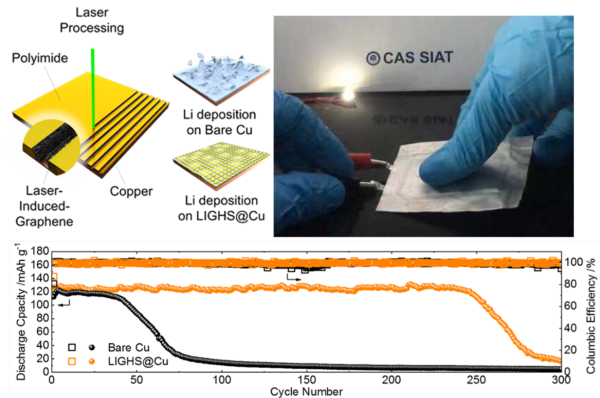Facile Patterning of Laser-induced-Graphene with Tailored Li Nucleation Kinetics for Stable Lithium Metal Batteries
Metallic lithium is the ideal anode material for rechargeable batteries because of its high theoretical specific capacity of 3860 mAh g-1 and low electrode potential of -3.040 V compare with standard hydrogen electrode.
Substituting the graphite anode with metallic lithium is one of the most promising strategies to improve the energy densities of the current rechargeable lithium ion batteries (LIBS) to meet the goal of 400 Wh kg-1. Adopting lithium metal anode is also the prerequisite for novel high-energy chemistries such as lithium-sulfur and lithium-oxygen due to their relatively low working potentials.
In principle, these batteries could deliver energy densities as high as 600 Wh kg-1. However, the current lithium metal batteries (LMBs) are still plagued by low coulombic efficiency, fast capacity degradation, and safety hazards. While the detailed mechanisms are still under intensive investigations, the parasitic reactions between metallic lithium and the electrolyte, the piercing and rebuild of solid solid-electrolyte interphases (SEIs), and the growth of dendrites are recognized as the major sources of instability.
The research group led by Dr. LU Ziheng and YANG Dr. Chunlei developed a facile and scalable approach to stabilize the lithium metal anode by regulating the Li nucleation and deposition kinetics with laser-induced graphene (LIG).

Novel current collector based on laser-induced-graphene and the electrochemical performance of a the lithium metal battery (Image by LU Ziheng)
By processing polyimide films on copper foils with a laser, a 3D-hierarchical composite material is constructed, consisting of a highly conductive copper substrate, a pillared array of flexible polyimide, and most importantly, porous LIG on the walls of the polyimide pillars. The high number of defects and heteroatoms present in LIG significantly lower the Li nucleation barrier compared to the copper foil. An overpotential-free Li nucleation process is identified at current densities lower than 0.2 mA/cm2.
Theoretical computations reveal that the defects serve as nucleation centers during the heterogeneous nucleation of lithium. By adopting such composites, ultrastable lithium metal anodes are obtained with high coulombic efficiencies of ~ 99%. Full lithium-metal cells based on LiFePO4 cathodes with a material loading of ~15 mg/cm2 and a negative/positive ratio of 5/1 could be cycled over 250 times with a capacity loss of less than 10%. The current work highlights the importance of nucleation kinetics on the stability of metallic anodes and demonstrates a practical method toward long lasting Li metal batteries.
The paper “Facile Patterning of Laser-induced-Graphene with Tailored Li Nucleation Kinetics for Stable Lithium Metal Batteries” was published on Advance Energy Materials.
| Download the attachment: |
|
|